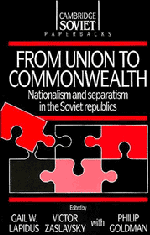Book contents
- Frontmatter
- Contents
- Notes on the contributors
- Preface
- Glossary
- Map: the Soviet Successor States
- 1 Introduction: Soviet federalism – its origins, evolution, and demise
- 2 State, civil society, and ethnic cultural consolidation in the USSR – roots of the national question
- 3 From democratization to disintegration: the impact of perestroika on the national question
- 4 The evolution of separatism in Soviet society under Gorbachev
- 5 Perestroika and the ethnic consciousness of Russians
- 6 Nationality policies in the period of perestroika: some comments from a political actor
- Index
1 - Introduction: Soviet federalism – its origins, evolution, and demise
Published online by Cambridge University Press: 03 May 2011
- Frontmatter
- Contents
- Notes on the contributors
- Preface
- Glossary
- Map: the Soviet Successor States
- 1 Introduction: Soviet federalism – its origins, evolution, and demise
- 2 State, civil society, and ethnic cultural consolidation in the USSR – roots of the national question
- 3 From democratization to disintegration: the impact of perestroika on the national question
- 4 The evolution of separatism in Soviet society under Gorbachev
- 5 Perestroika and the ethnic consciousness of Russians
- 6 Nationality policies in the period of perestroika: some comments from a political actor
- Index
Summary
The changing nature of Soviet federalism
For decades, obsessive Soviet preoccupation with external security spurred the development of a massive military establishment as well as a gigantic military-industrial complex to support it. But ultimately the primary threat to the stability and territorial integrity of the USSR came from within. The failure of the coup attempt of August 1991 accelerated a process of disintegration which was already under way, and gave new impetus to the demands for independence by many of the constituent republics of the former union. Disintegration now threatens the Commonwealth of Independent States itself, and ethnic minorities in Georgia, Moldova, and Russia are asserting their own claims to statehood.
This volume focuses on the fundamental sources of the Soviet Union's transition from a stable and highly centralized state to a system in chaos, as well as on the forces that will shape the post-coup future of what was once the Soviet Union. Three issues are of key importance: the. relationship of the union republics to the center, the relationship of ethnic minorities to the republics in which they reside, and the future political and economic role of the Russian Federation. These relationships, in turn, have been profoundly shaped by the nature of the Soviet system, and particularly by the initial decision to organize the Soviet state on the basis of a hierarchy of ethnoterritorial units.
- Type
- Chapter
- Information
- From Union to CommonwealthNationalism and Separatism in the Soviet Republics, pp. 1 - 21Publisher: Cambridge University PressPrint publication year: 1992
- 3
- Cited by



